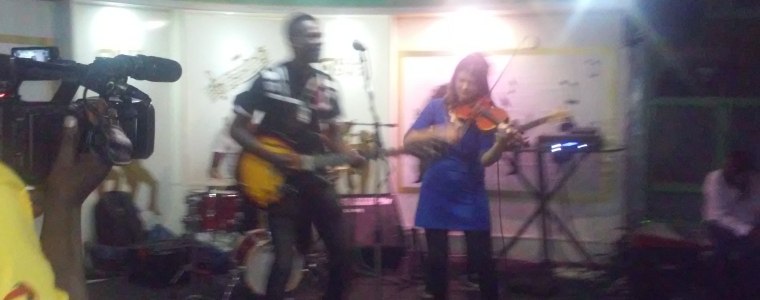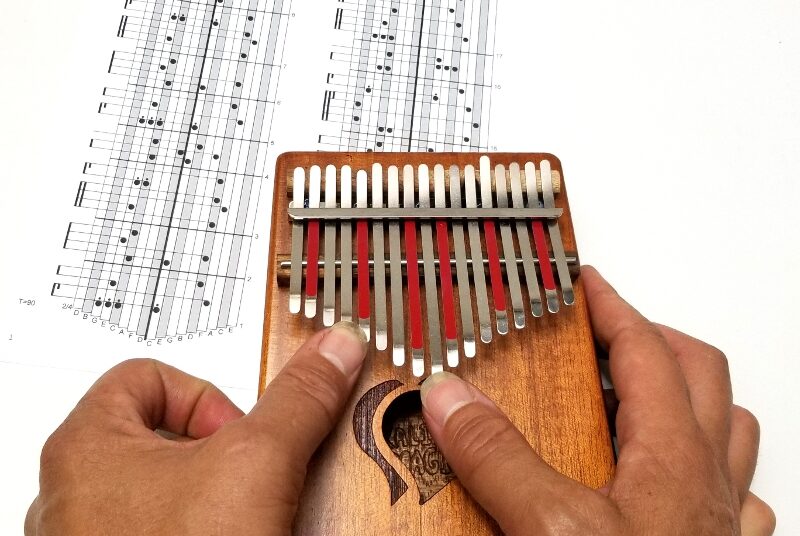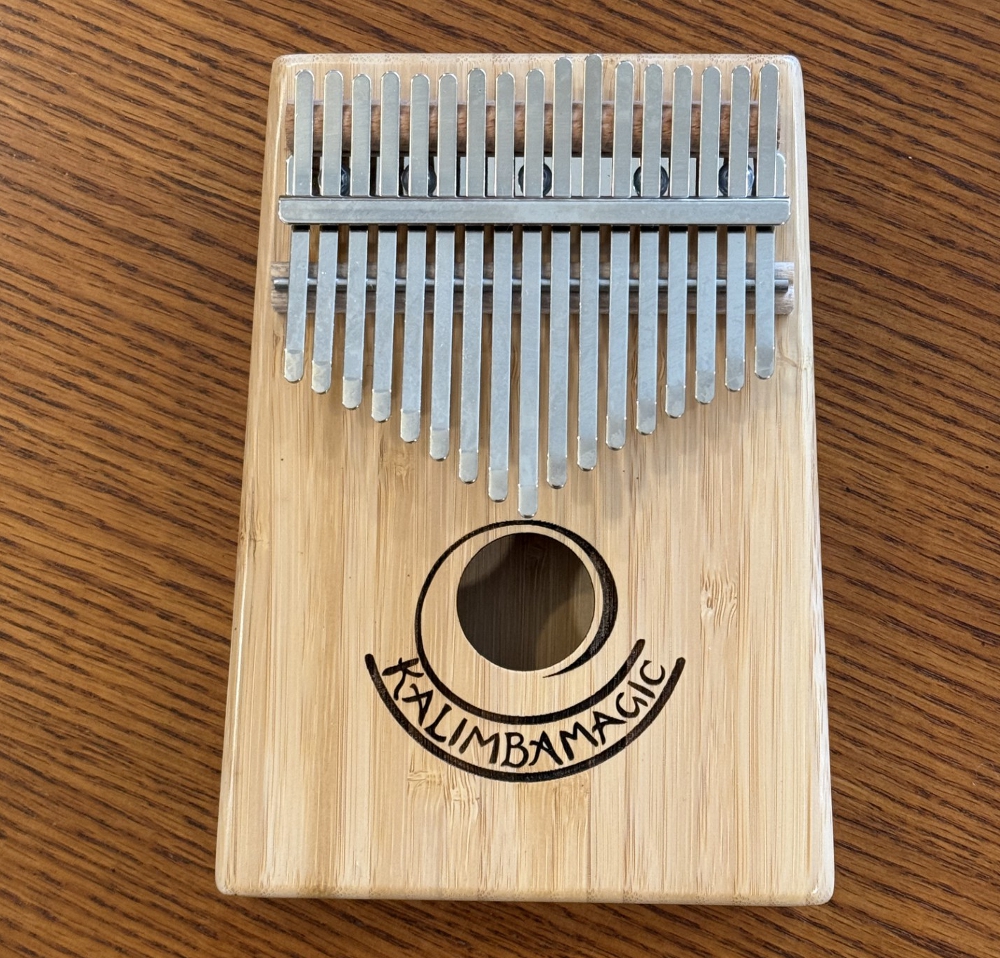
Use of this website constitutes acceptance of the Privacy Policy and User Agreement. Copyright © 2020 Kalimba Magic. All Rights Reserved.
Editor’s note: Klara is a valued contributor to the Kalimba Magic blog. She is currently spending some months in Zimbabwe developing her mbira skills, and has given us another rich, intelligent and stimulating piece; here she considers the sensitive cultural issues around her endeavor. The Bridge that Klara writes about (the Machipisa Foot Bridge in the city of Harare) was first built in 1998. Its journey from a very scary place to what it is now is discussed in the two articles linked at the bottom of this page. These articles, from local periodicals, give a rare glimpse into life in a faraway place, and it’s where Klara is living and learning right now. Photos and informative video included.]
The week that I came to Zimbabwe I was invited to perform under a bridge. The Bridge is an interesting contemporary cultural artifact; blessed by His Excellency Himself, it was built across a particularly dangerous bit of road in Highfield, the high-density suburb from which hail many of the political revolutionaries of pre-Independence days as well as the celebrated and revered musician, Oliver Mtukudzi. The Bridge swirls up from the ground on one side of the road like an artful ice cream cone, stretches its spine across the street, and then lands gracefully in a concrete pirouette on the other side. The Bridge is a testament to the human desire to make things better for ourselves.
Yes, I, a white European woman, was invited to play traditional karimba, in Zimabwe, under The Bridge…
Only nobody crosses the Bridge. For whatever strange reason, the Bridge had been left to drug addicts and those men who wished to relieve themselves in a most epic and demonstrative fashion – above ground, for all oncoming traffic below it to experience. And so in an effort to revitalize the Bridge, a Zimbabwean arts foundation has organized weekly performances in one of the concrete swirls, for all kinds of performers – from acrobats to musicians to thespians. These concerts are quite popular and well attended, with a crowd swirling up within the concrete base of the bridge, lapping up the shows, often recording them on cell phones.
Under that bridge that first week in Zimbabwe, I was invited to perform with Mhanda Acoustics, led by Brezhnev Guveya. We rehearsed once, and the band was delighted with my rendition of Chiwoniso Maraire’s version of ‘Vana Vanogwara’ (The Children are Crying), an old traditional Shona song. Brezhnev (Maestro we Mhanda) decided we would open our Saturday set with that piece. And so on that Saturday morning, I played a Hugh Tracey karimba under the concrete bridge in Highfield, and the crowd laughed in perhaps some mockery, but – so I was told – more in delight, to hear a foreign white woman sing a traditional song in the Shona language, on a Zimbabwean instrument. The karimba is only two keys away from the mbira nyunga nyunga, and Zimbabweans consider the karimba to be as close to the nyunga nyunga as we regard a sibling or child.

Klara playing violin with Mhanda Acoustics under The Bridge
Being white in Zimbabwe is a constant adventure – an adventure that, as one acquaintance here noted, best remain that, or else it is easy to get tired very quickly. The calls of ‘murungu!’ (white person, foreigner, or these days – boss), and ‘sweetie’, and ‘I love you’ and ‘I want to fuck you,’ take their toll certainly. But when you reply to these comments with Shona phrases, when you start chasing mapira ceremonies [see The Role of Mbira in Shona Culture, link below] openly and enthusiastically, when you cradle the mbira you are learning to play in kombis [a minibus] and in town – then the playful attitude toward the tourist changes quickly to be replaced either with mirth or suspicion. It is one thing to be a foreigner visiting Zimbabwe; being a foreigner invested in old Zimbabwean culture is another. As one of my mbira teachers told me: “The interesting thing about Zimbabweans is that they are ashamed of the mbira and their old culture. The churches don’t help with that. Zimbabweans will pretend that they don’t like mbira, but then if you have an mbira and you are playing it, they will stop and listen and they just love the sound.” Zimbabweans’ relationship with their culture is, like everybody’s relationship with their culture everywhere in the world, extremely complicated. They may hate it or feel ashamed, but when foreigners are interested, they become possessive. Because what do those foreigners see in it? Is it that they want to exploit it all over again?
Any people that has been colonized and exploited will stay wary of any hint of possible exploitation. This isn’t just true for societies – it is also true for individuals (speaking as a formerly-exploited woman!) A tree of colonization sprouts flowers of paranoia.
The mbira dzavadzimu, the instrument also known as the nhare, is associated here with African Traditional Religions. It is the only mbira that is wholly distinctly Zimbabwean, and the only mbira that is used in mapira ceremonies, when the spirits come and possess spirit mediums, take snuff (bute), drink traditional beer, and tell their stories – whether it be advice to an individual, or a history to a community. Here the spirits get to stretch their limbs in real human bodies, and dance with solid heels digging into solid earth. Historically, this is why the mbira as an instrument was suppressed and discouraged by Christian missionaries[1], and why, in a land of booming Christian churches and prophets whose coffers grow fat from sucking dry the thinning pockets of their congregants, the mbira is still viewed with some suspicion (even if, as my teacher said, “Secretly, everyone likes it.”) Israel Israel, a well-known mbira musican from Bulawayo (Zimbabwe’s second-largest city) is described in a local blog this way: “Israel believes indigenous musical instruments are despised because pioneering Christian missionaries brainwashed Africans when they came to evangelise Africa.”[2]
No wonder then, that some Zimbabweans may be suspicious of the new mbira renaissance blossoming in large part through its use and popularity outside of Zimbabwe.
Because the mbira is an instrument, and because it is not as popular perhaps as the djembe [the rope-tuned, skin-covered, goblet-shaped drum] in terms of African instruments worldwide, it has so far not been seen in the same category of a “cultural appropriation.” But can there be such a thing as musical cultural appropriation? Certainly not, I feel. If you put in the time, energy, and effort to learn an instrument, then that instrument speaks to you and through you, and it doesn’t matter what your skin pigmentation or your history are. Instruments already speak differently through every person who plays them. Despite our formalization and emphasis on technique, all instruments speak differently in different hands. As a player, you form a relationship with the instrument. I am in Zimbabwe right now forming a relationship with the mbira. Still, when I told one of my mbira teachers that I would like to go to a bira, he said: “We will have one in our village in July, but you will be gone by then…” I told him “No, no, I will still be here.” He gave me an apologetic look, hunched down awkwardly, and said: “I can’t bring a white person to a bira in my village… they would think I am maybe selling out…” The comment stung, and I didn’t ask again.
I mentioned the comment to one of my other mbira teachers. He said he taught a Swedish man mbira once. “The man learned well, and left Zimbabwe playing at a very high level, and even teaching mbira in his own country.” However, a friend of my teacher asked him, “Why are you giving our secrets away to that murungu?” My teacher responded, “Murungu or not, he is a human being and he wants to learn music.” (Certainly, as a violin player and teacher, I have never felt that the violin is reserved for people of a certain skin color or ethnicity, and I appreciated this teacher’s cordiality.) A few weeks later I attended my first bira ceremony. I was the only murungu there, and I was very welcome.
Still, the idea that I may not be welcome because I am a foreigner stayed with me, and it begs the question: Is the mbira a musical instrument, or an instrument of religious worship, or a marker of identity? There are plenty of bands in Zimbabwe that are not religious in nature that utilize the mbira to great effect musically. Even Thomas Mapfumo [the very famous Zimbabwean musician] was revolutionary in his use of mbira and guitar more for political purposes than religious ones.
But why the segregation of intentions at all? Why do we separate religious from cultural from historical from musical from political when every musical instrument, like every human being, is a unique blend of all of the above and can speak differently in different contexts, as expressed and as instructed? Similarly, why do we feel that foods, styles, clothes, or music and instruments are to be reserved to a place or a tradition?
Part of the answer lies, of course, in Zimbabwe’s history of being colonized both politically and religiously. Politicians suppressed culture for fear of an uprising (the image of legendary seer Chaminuka dying with his mbira in his hands, and Mbuya Nehanda hanging after speaking her truths in mapira ceremonies), and missionaries suppressed culture for fear of religious competition and spirits of ‘the devil.’ A man at the HIFA (Harare International Festival of the Arts) mbira stand this year said to me, “if our youngsters knew about mbira, and really knew how our Ancestors survived, how they knew where their enemies would be, where good game was, where to hunt, how to live – and that they learned all those things from spirits in the bira – if they really knew, then every youngster would be carrying around a mbira. They would be a fad. They would be more popular than cell phones.” Certainly, a fantastical image: instead of typing on Whatsapp, young people would be throwing their thumbs at mbira keys.
Zimbabwe was forcibly taught (by murungus) that its culture was bad. So how strange must it be to see a murungu come to Highfield and, playing a karimba, sing “Vana Vanogwara” under a vacant bridge, waiting for the flow of people to flood it with life? Like the mbira, the bridge must first be celebrated for people to choose to use it. Culture must first be honored before it can become a bridge across cultures and the world. Otherwise the culture will be viewed with suspicion, just like the people who come to learn it.
It is good to see that with the rise of mbira’s popularity in all of its forms, it is becoming one of Zimbabwe’s most effective and charming diplomats – drawing foreigners from all over the world to let go of their fears and come reside in this beautiful country, and spreading Zimbabweans and Zimbabwean culture in turn.


Sign up for our newsletter and free resources with your email address:
We pinky promise not to spam you and to only send good stuff.
 Seek to Infuse Your Musical Moments With Beauty and Magic
Seek to Infuse Your Musical Moments With Beauty and Magic Kalimba Magic – We Give You The Tools You Need to Succeed
Kalimba Magic – We Give You The Tools You Need to Succeed Back in Stock! The Bamboo-17 Kalimba
Back in Stock! The Bamboo-17 KalimbaUse of this website constitutes acceptance of the Privacy Policy and User Agreement. Copyright © 2020 Kalimba Magic. All Rights Reserved.